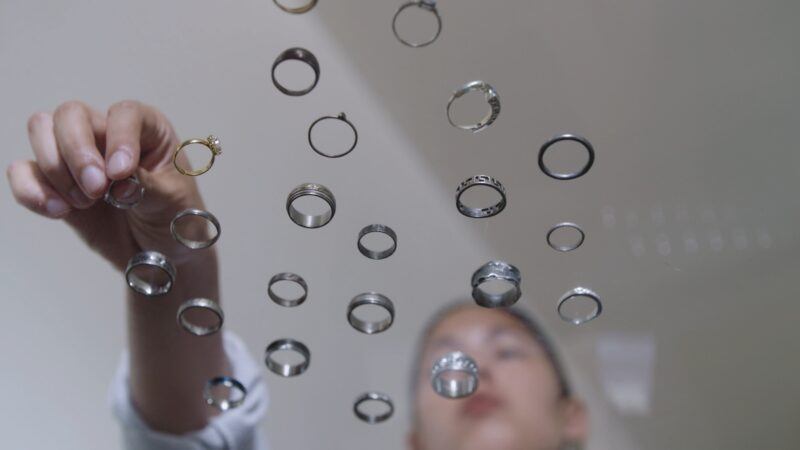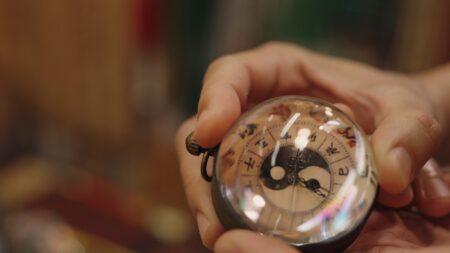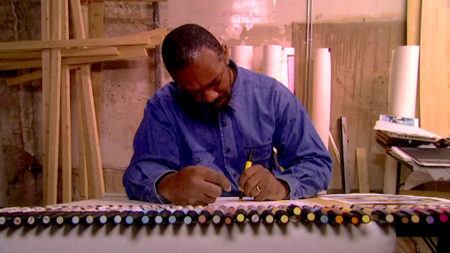Teaching with Contemporary Art
Objects Carry Meaning

Production still from the New York Close Up film, “Mary Mattingly Owns Up.” © Art21, Inc. 2013.
“Each object we own has this history that happened in the process of its making — its production and distribution, and how it’s affected the land around it,” says Mary Mattingly as she introduces her digital project, OWN-IT.US. She articulates the line of inquiry that inspired that particular project and many of her works as: “Why do I own them? How did they get into my life? And what’s my responsibility?” These three questions challenge each person in a deeply reflective way to evaluate their own personal collection of tangible objects and the journey they have made into our possession through mass production and consumption.
The New York Close-Up film was produced in 2013. A decade later, Mary Mattingly’s opening statements in the film feel even more potent now. “If we don’t start taking everything into account, our surroundings, our environment, we’re doomed to fail as a human race because we won’t be able to live on this earth,” she states. Her words are especially resonant today. With climate activists targeting artwork in galleries and the machine of consumerism showing no signs of stopping, I felt compelled to introduce my students to a unit focusing on the narrative possibilities of objects, as a call to action for them to embrace these ideas in their own practice.
Students were asked the same questions Mary Mattingly asked herself. This is an intentional teaching strategy I use in the classroom, to place the students directly in the mind of a contemporary artist. All objects tell a story, either in their manufacture, purchase, history, use, or path to an individual. The students’ challenge was to dive deep into the narrative possibilities of an object and figure out a way to display that narrative in a drawing or painting.

Production still from the Extended Play film, “Theaster Gates: Collecting.” © Art21, Inc. 2017.
While in the brainstorming and project development phase of the creative process, I also showed students works from Abigaille DeVille, Mark Dion, Theaster Gates, Damián Ortega, and Rose Salane. I feel it is important to show students that contemporary artists can all work within a similar theme or idea and each produce uniquely distinct artworks. This strategy gives students pathways to finding their own creative rhythm and shows them that no one way is the right way, as long as they stay true to their creative vision and are rooted in the unit’s essential question.
One student made a painting of an album by her favorite artist. This was the first album she purchased with her own money. She discussed her experience of making that purchase—the discipline to save up money, and the struggle to decide what to purchase. As time passed from that purchase, she wrote that it doesn’t even matter if she ever listens to that album ever again. Rather, it is now what that album represents to her that makes that object special.

Production still from New York Close Up film, “Rose Salane’s Lost & Found.” © Art21, Inc. 2022.
Another student made a drawing of a chain-link bracelet that was gifted to her by her mother. Inspired by artist Rose Salane’s exploration of jewelry left behind on New York public transit, this student wanted to explore the variety of narratives that can be distilled from a single piece of jewelry. The student experimented with a variety of compositions and symbolism behind each arrangement of a chain-link bracelet, opening and closing its sides to elicit feelings of strength and weakness from a “broken link” in a chain.
As the unit came to a close, we revisited the essential questions of the unit. We mainly discussed the question posed by Mary Mattingly: “What’s my responsibility?” This question reminded students to recall where we started, and how they navigated their creative process. Students had to articulate what they made and why. They had to revisit the origin story of the unit and see if they were aligned with their original intentions.

Production still from the New York Close Up film, “Abigail DeVille’s Harlem Stories.” © Art21, Inc. 2014.
In a roundtable discussion, a student casually mentioned that they never considered how one object could hold so many creative possibilities. And at first, it was overwhelming for that student to choose one of those possibilities to use as a driving force for the project. Many students echoed the same sentiment, with one student additionally following up by sharing their appreciation for the artists of reference. Contemporary artists are the foundation of my teaching strategies.
Rose Salane elaborates on her creative process that she has “always been interested in how an object could retell a personal history but also the familiarity in them that can trigger more questions and stories.” This idea seemed to resonate with the students. The process of developing these narratives instilled in them a sense of creative agency over how to interpret and express the objects that make up their world. The creative agency distilled from the narratives developed was evident in each artist shown throughout the course of the unit. Bringing these artists into the classroom in this way proved essential to this exercise and the educational process. Contemporary artists meet the challenges of our society, and show my students by example how being an artist is a viable and vital role for crafting the narratives of the future.



